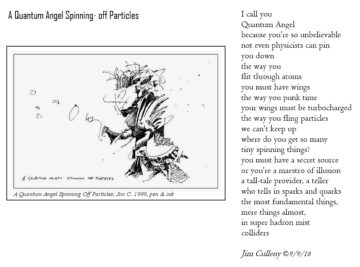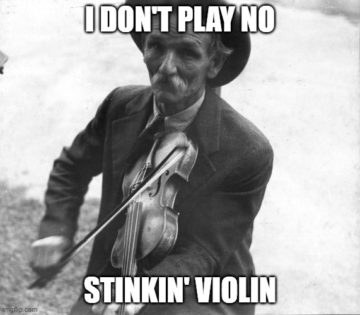
Monday Poem


by David J. Lobina

It is often stated that natural language is both ambiguous and inexplicit to be the medium of thought – to be the medium in which we think, as opposed to the conceptual language of thought I have gone on about for some time here at 3 Quarks Daily. But what do we mean when we say that language is ambiguous and inexplicit?
In the case of ambiguity, there are two relevant cases: lexical ambiguity, where a word may mean different things in different contexts (think of the word bank and all the things it can refer to); and structural ambiguity, as in the sentence below, which can receive different interpretations depending on what part of the sentence the phrase in Paris actually modifies.
The author of Stephen Hero decided to write Finnegans Wake in Paris.
That is, did the decision to write Finnegans Wake take place while the noted author was in Paris, or did the author of Stephen Hero decide that Paris would be a suitable place in which to carry out the foreseen writing? Or to put it in more linguistic terms: does the prepositional phrase in Paris modify the overall phrase decided to write Finnegans Wake or just the internal and thereby shorter phrase to write Finnegans Wake? Given the differing interpretations, such a sentence couldn’t possibly constitute an object of thought, for there is no such thing as an ambiguous thought. How could a person even have an ambiguous thought? Read more »
by Mark Harvey
 I’ve mostly escaped the selfie photo culture, not out of some virtuous modesty, but because I generally look like a confused mouth-breathing moron in photos. So selfies are more of an indictment for me than something I want to post on Instagram. If I photographed like a Benicio del Toro or George Clooney, all bets would be off. And before I offend and get canceled by any mouth breathers, I am part of the mouth-breathing family due to a deviated septum. At full rest, I sound like one of those artificial lungs in hospitals.
I’ve mostly escaped the selfie photo culture, not out of some virtuous modesty, but because I generally look like a confused mouth-breathing moron in photos. So selfies are more of an indictment for me than something I want to post on Instagram. If I photographed like a Benicio del Toro or George Clooney, all bets would be off. And before I offend and get canceled by any mouth breathers, I am part of the mouth-breathing family due to a deviated septum. At full rest, I sound like one of those artificial lungs in hospitals.
But, my God, there are a lot of people roaming the world who are convinced their friends and followers could use just one more shot of them doing the Bon Jovi fingers on a beach in Cancun. Everywhere you go couples, individuals and families are setting up little super-model sets angling for just the right light, just the right 4” jump off the beach, and just the right expression communicating spontaneity or expensive vacations or being included with the cool crowd.
Instead of going somewhere to enjoy the locale, near or far, social media has turned millions into location scouts ever seeking a good post. Maybe that’s why Mark Zuckerberg changed the name of his company to Meta. What’s more meta than dedicating half your awareness to how you’ll look in a photo? Read more »
by Oliver Waters
 Panic about runaway artificial super-intelligence spiked recently, with doomsayers like Eliezer Yudkowsy prophesising that, if current progress continues, literally everyone on Earth will die.
Panic about runaway artificial super-intelligence spiked recently, with doomsayers like Eliezer Yudkowsy prophesising that, if current progress continues, literally everyone on Earth will die.
In a way, he’s right. Humanity will probably die out as technology progresses, but not quite in the depressing way he imagines. ‘Humanity’ after all, refers to two distinct things. The first is our biological species – homo sapiens. The second is our collective cultural existence – the beliefs, attitudes, and creations that make us truly who we are. Our biology is merely a platform for our humanities to dance upon, and it is a platform that transhumanists wish to eventually supersede.
If all goes well, we will design and build better bodies and neural systems that more seamlessly integrate with our information technologies. On this trajectory, there will be no grand dichotomy between humans and ‘Artificial General Intelligences’. All persons, whether descended from apes or designed in a lab, will be constantly upgrading their cognitive systems to be ever wiser and sturdier.
The first big step on this journey will involve scanning your brain for all relevant neural information, which would then be loaded into a synthetic brain, attached to a comfortable artificial body. Science fiction has already imagined the countless benefits of existing in such a digital, computational brain. Practical immortality is at the top of the list, given you can ‘download’ your backed-up state of mind into a new body if you happen to be hit by a train or are notoriously assassinated. Read more »
by Muna Nassir

Sitting on the sill, head slightly resting on the pane, The Dubliners in hand, I look out the window, much like the eponymous Eveline, at the start of this particular short story. The darkness, in this case, is ready to invade not an avenue with concrete pavement and rows of redbrick terraced houses in Dublin, but an empty playground with bright coloured slides, swings, seesaws, and a roundabout in South Manchester. My vantage point allows me an eye level view of the giant oak sitting at the closest corner of the park, across the street. Unlike the slanted view from the living room, here, I can almost see the tiniest ferns sprouting on its bark. The oak’s tip points towards the sky with its thick branches spread out like the arms of a dervish in a trance. Bearing the weight of the subject in mind, I sigh in, inhaling the evening breeze. My nostrils detect not the smell of dusty cretonne but rather the scent of fallen leaves imbued with the myriad hues of autumn. From green to lime, to orange, red, maroon, and brown. The tree sits on a sideway, a space that seems to have been added as an afterthought, giving the park an irregular shape. Basking in another worldly silence, the oak exudes a stillness befitting the day’s retirement for the night. Read more »
by Nate Sheff
 Not long ago, I went to the Yale University Art Gallery and saw their collection of Egyptian art. Seeing the dates on some of the pieces, it occurred to me that I had never really considered just how old Egyptian civilization is. I looked up some historical events to get perspective, and learned that I am closer in time to the assassination of Julius Caesar (44 BCE, which is 2,066 years ago) than Julius Caesar was to the construction of the Great Pyramid of Giza (circa 2500 BCE, over 2,400 years before Caesar’s death). Caesar’s death is ancient history, and the building of the Great Pyramid is also ancient history, but – for the sake of perspective here – the Great Pyramid’s construction was also ancient for Julius Caesar. That’s how old Egyptian civilization is.
Not long ago, I went to the Yale University Art Gallery and saw their collection of Egyptian art. Seeing the dates on some of the pieces, it occurred to me that I had never really considered just how old Egyptian civilization is. I looked up some historical events to get perspective, and learned that I am closer in time to the assassination of Julius Caesar (44 BCE, which is 2,066 years ago) than Julius Caesar was to the construction of the Great Pyramid of Giza (circa 2500 BCE, over 2,400 years before Caesar’s death). Caesar’s death is ancient history, and the building of the Great Pyramid is also ancient history, but – for the sake of perspective here – the Great Pyramid’s construction was also ancient for Julius Caesar. That’s how old Egyptian civilization is.
Four-and-a-half millennia is a long time on a human timescale, but not all timescales are human. A core sample from Methuselah, a bristlecone pine living – alive – in the White Mountains of California, shows the tree to be about 4,800-years-old. By the time they started building the Great Pyramid, Methuselah had already spent a couple centuries photosynthesizing on a mountainside, adding rings but not counting them.
Methuselah is the oldest known non-clonal tree. When we consider trees that can reproduce asexually, say, by growing new individuals from existing root systems, we find organisms like Pando, a colony of genetically-identical quaking aspens in Utah, estimated to be about 15,000-years-old. Pando had been alive for several thousand years before Göbekli Tepe, the site of the earliest known megaliths, appeared in Anatolia.
Think of how many generations of birds might have started their lives in Pando’s branches by then. Read more »
by Brooks Riley

by Varun Gauri
 When Yiyun Li took questions about her new novel, The Book of Goose, at my local bookstore, someone said her new novel felt awfully dark. (I don’t remember the precise wording, though Yiyun might, as she sometimes offers people she has met briefly “a detailed account” of their encounter “out of mere mischief.”) Yiyun acknowledged the darkness, then offered an explanation — she was once a propagandist for the Chinese government, she was good at it, but now she hates propaganda, especially propaganda for life.
When Yiyun Li took questions about her new novel, The Book of Goose, at my local bookstore, someone said her new novel felt awfully dark. (I don’t remember the precise wording, though Yiyun might, as she sometimes offers people she has met briefly “a detailed account” of their encounter “out of mere mischief.”) Yiyun acknowledged the darkness, then offered an explanation — she was once a propagandist for the Chinese government, she was good at it, but now she hates propaganda, especially propaganda for life.
There was an audible gasp in the audience, then silence. I suspect many were asking themselves if they could manage without propaganda for life. In my case, I felt called out. What are A Christmas Carol, one of my favorite books, and the movie It’s a Wonderful Life, another favorite, but propaganda for life?
The Book of Goose is the story of two French farm girls, Agnès and Fabienne. Fabienne’s older sister died in childbirth, her father is a drunk, and her mother has passed away, meaning Fabienne has to tend the farm rather than attend school. Agnès’ older brother was badly wounded in the war, her sisters have gone and married, and her parents are narrow-minded and conventional. The girls, poor and lonely, already know the world is “full of nonsense.” Read more »
by Ed Simon
What then is time? If no one asks me, I know what it is.
If I wish to explain it to him who asks, I do not know. —Augustine, Confessions (397)
Time is what keeps everything from happening all at once. —Richard Cummings, The Girl in the Golden Atom (1922)
 Twenty-six years ago, on a late-afternoon, late-summer sojourn down Liverpool’s Bold Street, a High Street of dark pubs and record stores, Donner kebab counters and chip shops, Frank accidentally walked into 1965. On his idyl perambulations to meet up with his wife at Waterstone’s, where she was grabbing a copy of Trainspotting, and Frank noticed a different slant of light, an alteration in the atmosphere, a variation in the sounds from the street, a drop in temperature. The summer odor of warm beer and fetid air replaced with the crispness of Christmas time. Approaching the bookstore, the Cranberries blaring on the music system, and mid-tune it’s replaced with a tinny radio playing a Herman’s Hermits number. Bold Street’s pedestrians were no longer wearing Oasis and Blur t-shirts, now they were men in boating jackets and mop tops, women in Halston dresses and pixie cuts. The road no longer paved, but cobblestoned. Frank noted that the Waterstone’s façade was now of a shop named “Cripps,” a woman’s clothing store that had been on this spot but closed decades before. Just as he crossed the threshold, and Cripps was abruptly transformed back into a bookstore. Misapprehension, misconception, misinterpretation? Hallucination or hoax? Vortex or ghosts? As paranormal writer Rodney Davies helpfully opines in Time Slips: Journeys into the Past and Future, “One theory state that past, present, and future are all one… But our limited consciousness can only experience time by being in what we know as ‘the present.’” Mayhap.
Twenty-six years ago, on a late-afternoon, late-summer sojourn down Liverpool’s Bold Street, a High Street of dark pubs and record stores, Donner kebab counters and chip shops, Frank accidentally walked into 1965. On his idyl perambulations to meet up with his wife at Waterstone’s, where she was grabbing a copy of Trainspotting, and Frank noticed a different slant of light, an alteration in the atmosphere, a variation in the sounds from the street, a drop in temperature. The summer odor of warm beer and fetid air replaced with the crispness of Christmas time. Approaching the bookstore, the Cranberries blaring on the music system, and mid-tune it’s replaced with a tinny radio playing a Herman’s Hermits number. Bold Street’s pedestrians were no longer wearing Oasis and Blur t-shirts, now they were men in boating jackets and mop tops, women in Halston dresses and pixie cuts. The road no longer paved, but cobblestoned. Frank noted that the Waterstone’s façade was now of a shop named “Cripps,” a woman’s clothing store that had been on this spot but closed decades before. Just as he crossed the threshold, and Cripps was abruptly transformed back into a bookstore. Misapprehension, misconception, misinterpretation? Hallucination or hoax? Vortex or ghosts? As paranormal writer Rodney Davies helpfully opines in Time Slips: Journeys into the Past and Future, “One theory state that past, present, and future are all one… But our limited consciousness can only experience time by being in what we know as ‘the present.’” Mayhap.
If you are the sort who absent-mindedly scrolls through accounts of the occult with dubious provenance, or as has spent innumerable hours listening to Art Bell’s Coast to Coast A.M., if you’ve ever heard of “John Titor” and wanted to believe, then you may already be familiar with Frank’s temporal flickering in the “Liverpool Time Slip.” Not the only such anomalies – there are accounts of tourists coming upon Marie Antoinette’s retinue while at Versailles and of guests in Cornish manor houses wandering into the seventeenth-century, backroad drivers in Arizona overtaken by futuristic vehicles and London streets destroyed by the Luftwaffe restored to pre-war completeness. Read more »
by Andrea Scrima
Sequel to the essay “Musings on Exile, Immigrants, Pre-Unification Berlin, Trauma, Naturalization, and a Native Tongue.”

It’s disorienting when cities lose their gray zones—the undefined plots of fallow land that used to line the banks on the Brooklyn side of the East River, for instance, the nineteenth-century warehouses, docks, and quietly deteriorating, decommissioned refineries. Crumbling cement made porous by weather and weeds, the whole of it replaced now by faceless, blue-hued high-rise towers of glass and steel that sprang up like mutant mushrooms over the past decade and a half to block the path of the evening sun along the waterfront, erase the sharp glint of silvery light that once illuminated defunct railroad tracks at sundown, their perfectly parallel lines momentarily ablaze with the recollection of past importance. In Berlin, wasteland terrains could be found nearly everywhere before the Wall came down: the long stretch of a discontinued S-Bahn line that led from Monumentenstrasse and over the bridges at Yorckstrasse up to the former railway terminus Anhalter Bahnhof, now a ruin consisting of no more than a fragment of the once-massive building’s façade, where a semicircular set of overgrown train tracks opened onto the remains of a round loading dock. A decade and a half after Allied bombs had obliterated much of Germany, its division into two countries produced a haphazard border that sliced through the massive reconstruction project underway, blocking streets and cutting through buildings and canals and occasionally giving rise to little pockets of land connected to West Berlin by long roads flanked on either side by the Wall. Read more »
by Mike Bendzela

“What genre do you play in, Mike?”
“Old time.”
“That’s rather vague, isn’t it?”
[An actual conversation.]
Old time music (some write “old-time” or “oldtime”) is where my interests in rural American folk history, cultural evolution, and language-play come together to form a most satisfying way to lay waste to time. Yes, old time is a thing.
At the end of the last century, at the age of 39 and seemingly without conscious volition, I rented a violin. I thought I wanted to be a “bluegrass” player. I was so naive I had to ask the clerk at the music rental store, Is the fiddle the same as the violin?
The answer is, Yes, but no. Turns out, I wasn’t actually interested in playing no stinkin’ bluegrass violin. This requires some explanation.
The radio station at the local university where I work used to have a program called “Lost Highway,” which featured old country music: folk, old time, honky-tonk, all of which I thought of as “bluegrass.” Some of this bluegrass I liked; some of it I found extremely irritating. I had yet to learn the fine distinctions among genres. But some of this music was enchanting, haunting, primeval.
Then, in 2002, I swung by The Appalachian String Band Festival (“Clifftop”) at Camp Washington-Carver, in the West Virginia mountains, on the way back to Maine after a family reunion with some relatives in Kentucky. I tend toward social avoidance and usually don’t go to such places, but Clifftop turned out to be a road-to-Damascus moment for me: At last, I had found my genre—and, presumably, my people. When I expressed my amazement over lunch to an Asian-America fiddler and software developer sitting at a picnic table with me, he enthused, “Start listening to Bruce Greene!” I was on my way to learning a new language. The timing was perfect: my ambitions of being a fiction writer had quietly crashed, and I was seeking something redemptive to do. Finding old time was like being handed a loaf of crusty bread after a ten-year diet of wet sawdust. Read more »
by Carol A Westbrook
Oh, where were you in Chicago?
You know I didn’t see you there
I didn’t see them crack your head
Or breathe the tear gas air
Oh, where were you in Chicago
When the fight was being fought?
Oh, where were you in Chicago?
‘Cause I was in DetroitWhere were you in Chicago? —Written and performed by Phil Ochs.
 When I heard that Chicago will host the 2024 Democratic National Convention next August, (August 19-22,) it brought back a flood of memories. Memories, not only of the convention itself, but of the 60’s. “The 60’s” did not exactly span the decade but began in 1963 , when John F Kennedy was shot, and ended in 1975, when the war in Vietnam ended. During this relatively short period, our country went through a large number of societal changes, including political changes, changes in gender stereotypes, in racial interactions, in acceptable speech, in sexual mores. This was the time when we Baby Boomers came of age, when the 76 million Americans born between 1946 and 1954, began to flex their muscles and recognize how much they could accomplish, and what a loud voice they had when acting as a group. For example, they influenced clothing styles and music. They had tremendous purchasing power, as most of the clothing for sale after the 60’s was more appropriate for a-19–year-old than for a 40 or 50- year old American!
When I heard that Chicago will host the 2024 Democratic National Convention next August, (August 19-22,) it brought back a flood of memories. Memories, not only of the convention itself, but of the 60’s. “The 60’s” did not exactly span the decade but began in 1963 , when John F Kennedy was shot, and ended in 1975, when the war in Vietnam ended. During this relatively short period, our country went through a large number of societal changes, including political changes, changes in gender stereotypes, in racial interactions, in acceptable speech, in sexual mores. This was the time when we Baby Boomers came of age, when the 76 million Americans born between 1946 and 1954, began to flex their muscles and recognize how much they could accomplish, and what a loud voice they had when acting as a group. For example, they influenced clothing styles and music. They had tremendous purchasing power, as most of the clothing for sale after the 60’s was more appropriate for a-19–year-old than for a 40 or 50- year old American!
I am a Boomer, and I turned 18 in 1968. High school graduation was behind me, and I was looking forward to college in October at University of Chicago. The summer was fun.
I had a part-time job in an office, so the hours were short and I had plenty of time to go to the beach or to socialize in the long, hot summer evenings of the Midwest. My boyfriend, Greg, enjoyed driving, so he took me around the city a lot. I had a good friend who was volunteering for McGovern’ campaign. We Boomers supported McGovern because he was anti-war– which seemed to be the most important quality a candidate needed to get this the votes of our large block. Although quite frankly I was always more interested in feminist issues. Read more »
by Rebecca Baumgartner

Do you watch TV with subtitles, even when watching something in your native language? I never used to, but over the past 10 years or so, it started to feel more and more necessary, and now if I try to watch something without them, I inevitably miss a few bits of dialogue and it drives me crazy. It’s not just when characters speak sotto voce or very quickly (although witty, fast-paced shows like Gilmore Girls virtually demand to be watched with subtitles for that very reason). Even dialogue that’s meant to be at normal speaking speed and volume sometimes just doesn’t sound as clear as it should.
When I came across a recent piece by Devin Gordon in The Atlantic titled “Why Is Everyone Watching TV With the Subtitles On?” my interest was piqued. When I mentioned the article to my husband, his response was, “Oh, good, is it going to talk about how you can’t hear dialogue clearly in TV shows anymore?”
What I expected was an insightful analysis of audio trends in the film industry over the past few years and maybe some corporate shenanigans on the part of the streaming companies (more on that in a bit), but what I got was…complaining about millennials? Yes, that’s right, the article began by blaming the prevalence of subtitles on millennials. Read more »
by Ashutosh Jogalekar

This is the sixth in a series of essays on the life and times of J. Robert Oppenheimer. All the others can be found here.
Colonel Leslie Groves, son of an Army chaplain who held discipline sacrosanct above anything else in life, had finished fourth in his class at West Point and studied engineering at MIT. He had excelled in the course of a long career in building and coordinating large-scale projects, culminating in his building the Pentagon, which was then the largest building under one roof anywhere in the world. In September, 1942, Groves was wrapping up and eager to get an overseas assignment when he was summoned by his superior, Lieutenant General Brehon Somervell. Somervell told Groves that he had been reassigned to an important project. When Groves irritably asked which one, Somervell told him that it was a project that could end the war. Groves had learned enough about the fledgling bomb program through the grapevine that his reaction was very simple – “Oh”.
Robert Oppenheimer is the most famous person associated with the Manhattan Project, but the truth of the matter is that there was one person even more important than him for the success of the project – Leslie Groves. Without Groves the project would likely have been impossible or delayed so much as to be useless. Groves was the ideal man for the job. By the fall of 1942, the basic theory of nuclear fission had been worked out and the key goal was to translate theory into practice. Enrico Fermi’s pioneering experiment under the football stands at the University of Chicago – effectively building the world’s first nuclear reactor – had made it clear that a chain reaction in uranium could be initiated and controlled. The rest would require not just theoretical physics but experimental physics, chemistry, ordnance and engineering. Most importantly, it would need large-scale project and personnel management and coordination between dozens of private and government institutions. To accomplish this needed the talents of a go-getter, a no-nonsense operator who could move insurmountable obstacles and people by the sheer force of his personality, someone who may not be popular but was feared and respected and who got the job done. Groves was that man and more. Read more »
before the sun rose, they rose,
they were soft-spoken to shadows
so as not to stir them
they let blood and would sometimes sweat and spit.
when shadows were too cruel. they prayed for light
tree’s sunlit shadow: big trunk moves in wind
limb dangling, brushes asphalt
ah! Matryoshkas, nesting shadows easily swallowing
tiny others,
……………….huge devours small
shadow peas in a shell-game of
ballooning unknowns in onion-like layers of doubt
balanced upon a fulcrum, at rest in a dissatisfying
but absolute equation:
(the known-miniscule) + (the unknown-immense)
are ever balanced
………………………………………………………………………… So,
Jim Culleny
©11/15/15-Rev. /6/25/23
by Joseph Shieber

In “The Bizarre Bad Criticisms of Our Merit Paper,” a recent blog post in defense of the “Defense of Merit in Science” paper, the Rutgers psychology professor Lee Jussim doubles down on the conflation of “merit” with “objective truth.”
For example, in highlighting what he takes to be an underlying logical incoherence of criticisms of the “Merit” paper, Jussim writes this:
Anyone who believes the critics [sic] claims have merit (including the critics themselves) implicitly accepts our central argument that science has to be judge [sic] on its merits, even if they pose as critiques of our paper.
And this:
It is impossible for there to be no scientific merit and for the claim that there is no scientific merit to … have merit.
The problem is that there is a difference between saying that scientific CLAIMS should stand and fall on their merits and that scientists’ success should be determined by their merits. The former statement has to do with standards of evidence and objective truth. The latter statement, in contrast, has to do with qualities of scientific researchers correlated with advancing science, as well as with our confidence in our abilities accurately to assess those qualities.
It shouldn’t need stressing, but perhaps it does. What makes a statement or claim meritorious – its originality, interest, truth-likelihood, etc. – is different than what makes a PERSON meritorious. One obvious difference, of particular importance given Jussim’s own focus on objective truth, is that PERSONS aren’t truth-evaluable. Read more »
by Jochen Szangolies

In the previous column, I wrote about how forces originate from quantum mechanics, using the electric force as an example. Rather than being caused by ‘virtual’ particles being tossed back and forth, which is a picture that seems alluringly intuitive, but ultimately misleads more than it clarifies, a better way is to think in terms of the most characteristic feature of quantum mechanics: interference. Quantum objects, you recall, may appear as particle-like dots upon measurement (say, causing a tiny dark spot on a photographic plate), but are best described in a wave-like manner otherwise. And, while particles can only pile up, waves can both reinforce each other and cancel out, which leads to the familiar pattern of interference.
Interference is most often discussed in terms of the double slit experiment, where, say, electrons are aimed at two narrow, nearby apertures, and, rather than just piling up behind each slit, produce a picture of bands of greater and lesser intensity. But in fact, interference isn’t just important in the quantum realm in the course of clever experiments in which scientists try to get the quanta to identify, once and for all, as wave or particle, only to be frustrated by their refusal. In an often quoted heuristic, suppose what happens if one particle is sent to an aperture with three slits, or four, or five, or more than one aperture: each time, you have to sum the contributions along each possible path to obtain the final intensity at any possible end point of its journey. But once you take that process to the limit, where you have ‘slits everywhere’, at every point in space, you find you can still use that same prescription: sum up the contribution of every possible path, to obtain the intensity (or the probability of finding the particle) at each final point. Thus, we were led to Feynman’s ‘sum over paths’-picture of quantum mechanics. Read more »